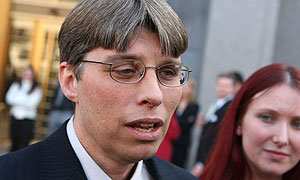Nine developments of interest to fans:
(1) The end of the story run here about decommissioning ceremonies for Star Trek: The Experience has been written at Trekmovie.com:
On Monday September 1st, 2008, over 1500 fans gathered in the Space Quest Casino inside the Las Vegas Hilton, to pay their final respects and observe the final decommissioning ceremony of Star Trek: The Experience.
(2) Harlan Ellison has sued Paramount alleging the studio is withholding payment after licensing the rights to the plot of his “City on the Edge of Forever” Star Trek episode to Simon & Schuster.
(3) What the Talking Squid says is true:
Just look at what Zadie has done here: she has managed to write an exceptionally interesting introduction to a man who was not particularly interesting by any of the standard measures.
(4) In 2006, while they were in the neighborhood for L.A.con IV, the Heinlein Society paid a visit to the LaurelCanyon (Los Angeles hillside home that Robert and Leslyn Heinlein bought in 1938:
The house…is partly described in several stories, including “Year of the Jackpot” and “And He Built a Crooked House.” Later, the Manãna Literary Society would often meet in this house, as described in Anthony Boucher’s Rocket to the Morgue.
(5) Thanks to arrangements made by Steven Silver, the official Hugo Awards website will soon have a photo of the 1982 Hugo to fill that page, instead of the little red “x” that’s been heroically performing that duty. The Chicago Worldcons of 1982 and 1991 used Lucite Hugo rockets instead of the more familiar chrome-plated rockets produced by Peter Weston — and when there was a raised-pinky objection on the Smofs list to calling these “plastic” Hugos, Dave Locke blinded them with science:
I dunno what they were, but Lucite is defined as a transparent thermoplastic acrylic resin. Maybe I’m wrong, but that sounds like one of the many sins below the ‘plastic’ umbrella.
(6) All this talk about historic Hugos has prompted Taral Wayne to claim his share of the credit for the 1978 Hugo trophy:
I was downloading photos of the Hugo awards and noticed that the credit line for the 1978 Phoenix Worldcon was blank. I don’t know who designed the base per se… What I can say now is that the art on the engraved plaque on the base is a piece of art of mine. It was also used as a logo for the con, and put to various other uses. I don’t have one of the Hugos of course, but received a copy of the engraving anyway.
(7) Astronomers began discovering “hypervelocity” stars only recently: so far, they’ve spotted more than a dozen.
The stars stood out because they traveled faster than any stars ever seen — fast enough to completely escape the Milky Way. Here’s what some astronomers think may be happening. A binary star system — two stars bound by their mutual gravitational pull — skirts by the supermassive black hole. One star in the system enters orbit around the black hole, while the other star flies free of its companion. The first star eventually falls into the black hole, while the second star shoots away from the black hole at extreme speed.
(8) Janice Gelb asks, “Have you see the Diagram prize for the oddest book title of the year?” The Guardian has also posted a slide show of some of the covers.
(9) And there’s a brief note in the September 4 edition of Los AngelesTimes about how things are progressing in the Clark Rockefeller case:
Prosecutors in Massachusetts said Wednesday that they are close to securing an indictment for kidnapping against the man who portrayed himself as Clark Rockefeller, as authorities in Los Angeles continue to explore his possible connection to a double murder.
[Includes links via the Nashville club newzine, and Andrew Porter.]


